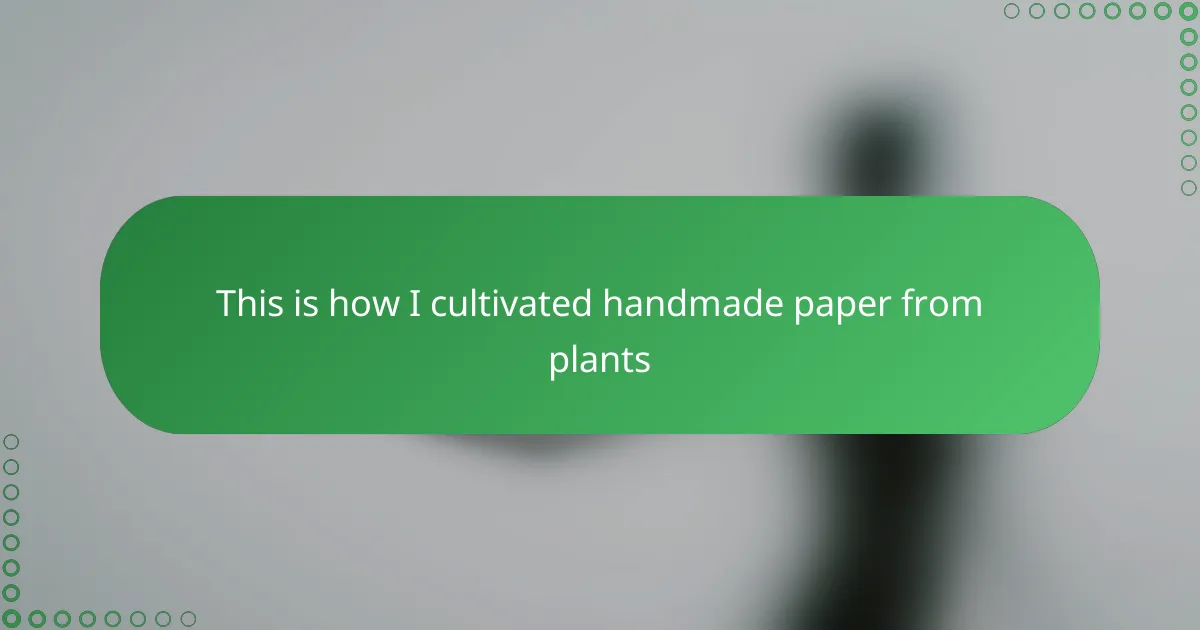Key takeaways
- Handmade paper crafts blend creativity with nature, showcasing unique textures and stories tied to their organic origins.
- Gathering materials, including fresh or recycled plant fibers, is essential for creating strong and beautiful paper, emphasizing choice and preparation.
- The crafting process involves patience and finesse, from preparing the fibers to careful pressing and drying techniques, reflecting the delicate balance required in both art and life.
- Improving paper quality can be achieved through techniques like adjusting soaking time and using fine mesh, highlighting the importance of details in handmade work.
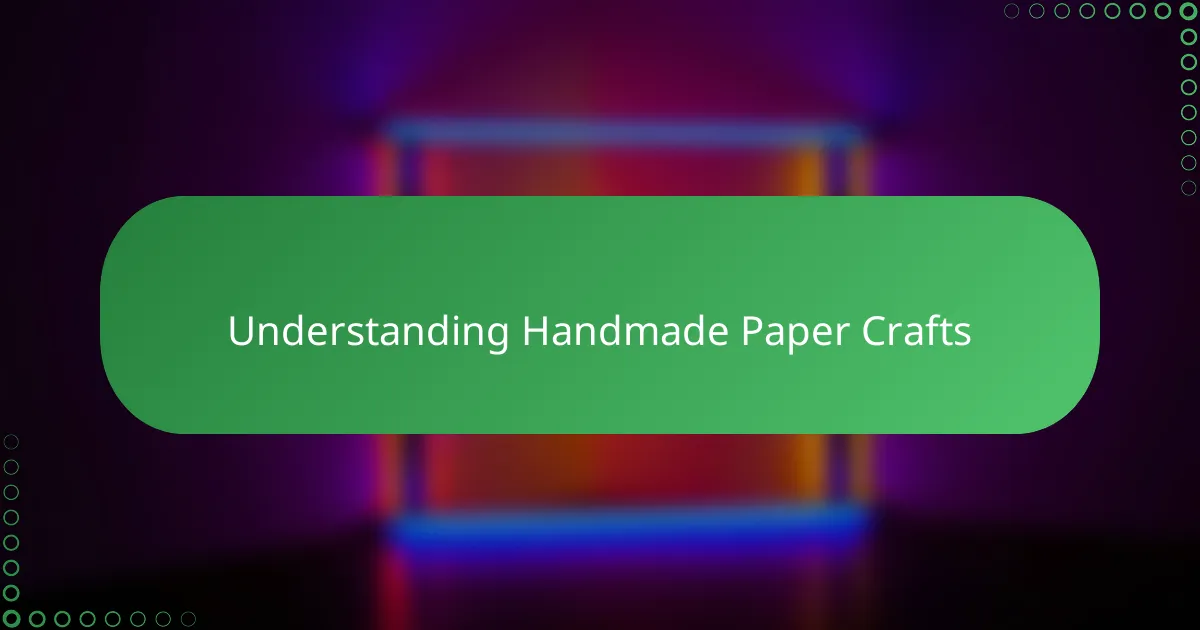
Understanding Handmade Paper Crafts
Handmade paper crafts have always fascinated me because they connect creativity with nature in such an intimate way. Have you ever thought about how something as simple as paper can carry the unique textures and stories of its origin? It’s this deeply personal touch that makes handmade paper so special compared to mass-produced options.
From my experience, understanding handmade paper crafts means appreciating the craft as both an art and a tradition. It’s about seeing beyond the finished sheet and recognizing the labor, patience, and organic materials that come together to shape each piece. When I first tried making paper, I was amazed at how the fibers from plants transformed into a beautiful, textured canvas.
What’s truly captivating is how each sheet tells a story of growth, care, and craftsmanship. Do you ever wonder how these natural fibers become something you can write on or fold into an intricate design? This transformation sparks a sense of wonder that deepens my connection to both the craft and the natural world.
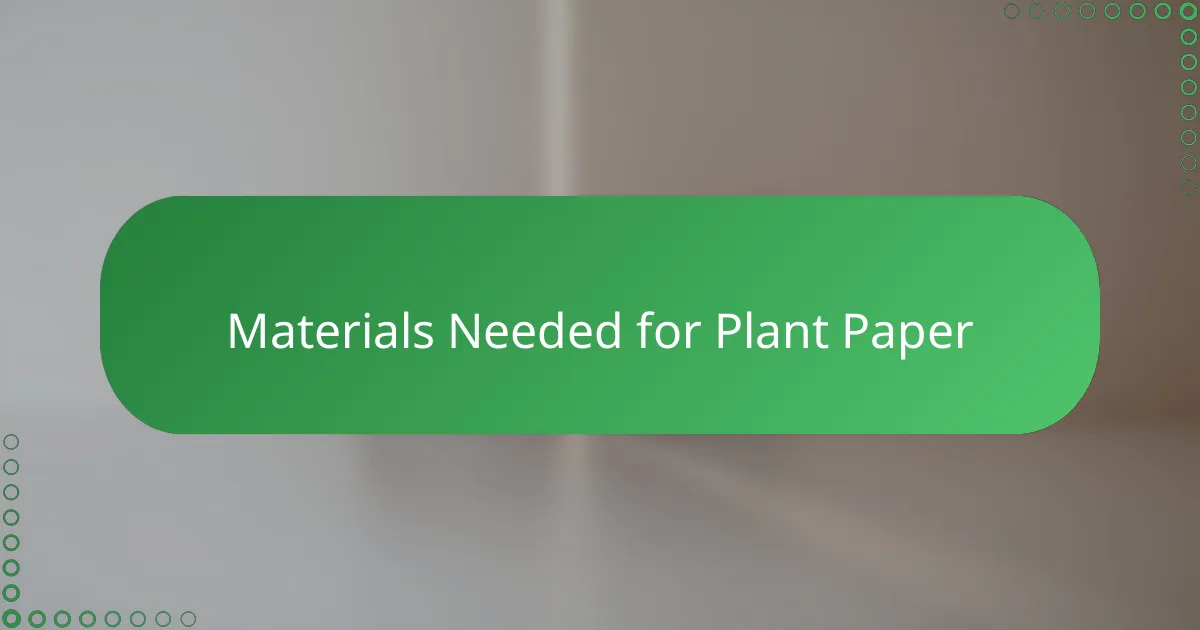
Materials Needed for Plant Paper
When I started crafting handmade paper from plants, gathering the right materials felt like preparing for a small adventure. The essentials are surprisingly simple: fresh or recycled plant fibers, a mold and deckle to shape the paper, a large basin filled with water, and some absorbent cloths for drying. Have you ever tried turning leaves and stems into something so tactile and meaningful?
I remember scouring my garden for fibrous plants like hibiscus and flax because their long fibers make the paper strong and beautiful. The process requires patience—not just in soaking and breaking down the fibers but in carefully selecting which plants will give the best texture and durability. It’s amazing how hands-on this craft truly is; every material choice shapes the character of the final sheet.
Of course, a blender or mortar and pestle comes in handy to pulp the fibers evenly, but I found that the natural grit and imperfections in plant material are what give handmade paper its soul. Collecting items like a sponge and a rolling pin for pressing the sheets completes the toolkit. Each piece of equipment, no matter how simple, plays a role in preserving the delicate balance between nature and craft.
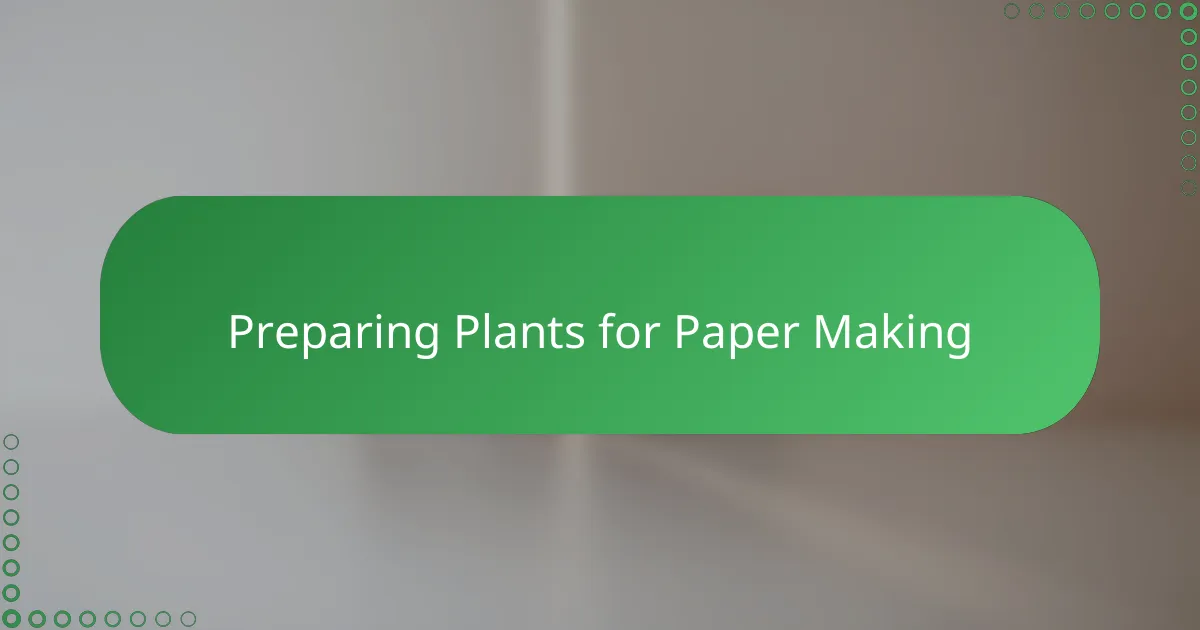
Preparing Plants for Paper Making
Preparing plants for paper making requires more than just picking greenery; it’s about knowing which parts hold the best fibers for a sturdy yet delicate sheet. I’ve learned that removing leaves and stripping bark carefully helps reveal the plant’s inner strength, which became clear the first time I experimented with hibiscus stems—the difference was night and day.
Once I gathered the right plant parts, soaking them allowed the fibers to soften and separate. This step felt almost like waking up the plant’s potential, turning tough stalks into a pliable pulp that I could mold. Have you ever noticed how something so rigid can suddenly become flexible with just water and time?
Breaking down the fibers was both physical and meditative for me. Whether pounding with a mortar and pestle or blending gently, I appreciated how the fibers loosened gradually, teasing out the natural texture that ultimately defines handmade paper. It’s this transformation that makes the preparation phase so rewarding—and, honestly, a bit magical.
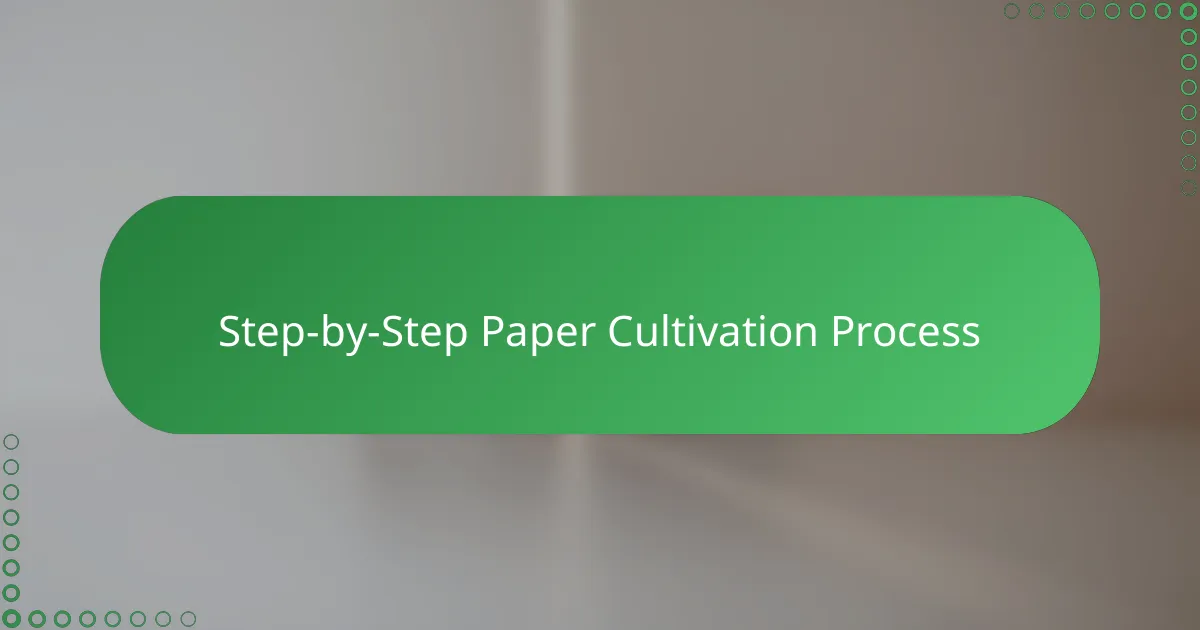
Step-by-Step Paper Cultivation Process
The next step after preparing the pulp is to carefully transfer it onto the mold and deckle, which shapes the paper’s future form. I remember the first time I dipped the frame into the vat of pulp—holding it steady as the fibers settled felt like catching a fleeting moment of creation. Have you ever tried to balance something delicate and unpredictable like that? It’s a small challenge, but it teaches you patience and attentiveness.
Once the pulp is evenly distributed, pressing out the excess water is critical. Using a sponge to gently press the wet sheet reminded me of how sensitive nature is—too much pressure, and the fibers could tear; too little, and the drying would take forever. This balance, I think, mirrors so much in life where gentle persistence is key.
Drying the paper is where anticipation and patience truly merge. I usually lay the sheets flat on absorbent cloths, watching as they transition from soggy pulp to sturdy paper felt surprisingly emotional, like witnessing the final act of a long, nurturing process. Have you noticed how something that started as mere plant fibers holds a unique beauty after drying—almost like a secret revealed?
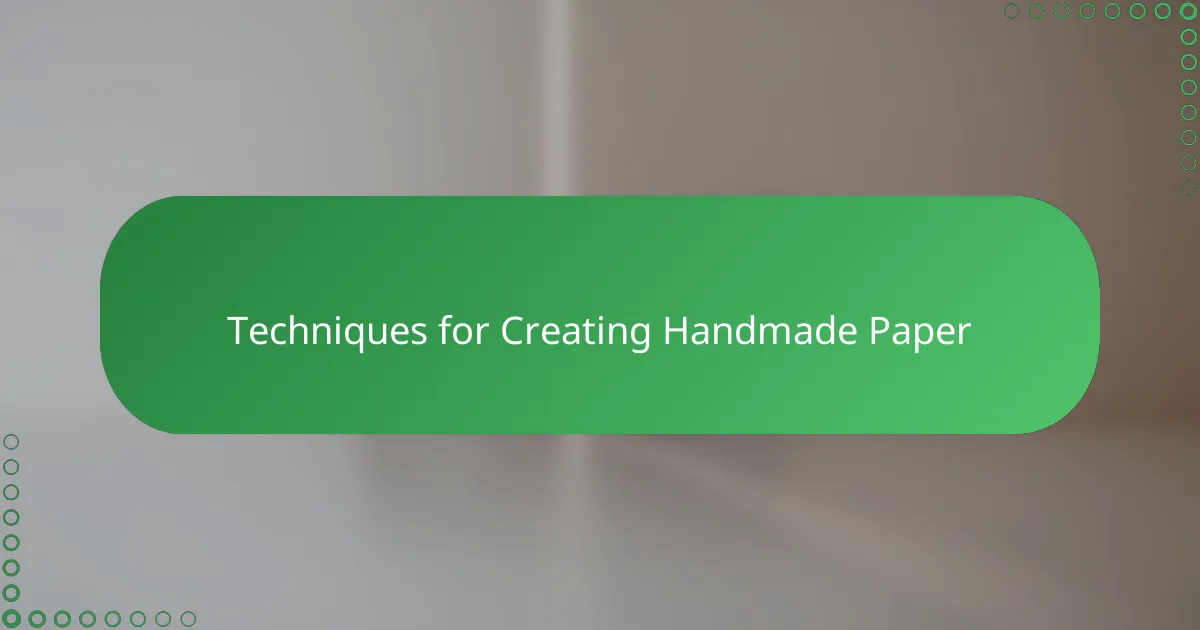
Techniques for Creating Handmade Paper
Crafting handmade paper demands a bit of finesse, especially when it comes to layering the pulp on the mold and deckle. I found that gently swishing the frame back and forth helped spread the fibers evenly, much like painting a delicate landscape. Have you ever experienced that moment when you realize a smooth base sets the tone for everything that follows?
Pressing and drying are arguably the most critical steps where patience truly pays off. I’ve learned to press the sheets with just the right amount of pressure—enough to squeeze out water but gentle enough to keep the fibers intertwined. It reminded me of handling fragile glassware; one wrong move, and the whole effort could be undone.
Finally, drying felt like waiting for a secret to reveal itself. Each sheet, once damp pulp, seemed to tell its own story as it hardened into paper. Sometimes, I’d gently peel off a corner to check the texture, marveling at how plant fibers had morphed into something both strong and beautiful. Isn’t it amazing how such simple techniques bring nature’s hidden art to life?

Tips for Enhancing Paper Quality
Improving the quality of handmade paper has always been a bit of an experiment for me. One trick I swear by is soaking the fibers longer when they feel too stiff; it really softens them, making the surface smoother and less prone to tearing. Have you tried adjusting soaking time? It’s amazing how this small change impacts the final feel of the paper.
Pressing the sheets evenly is another game changer. Early on, I pressed too hard and ended up with brittle paper, but once I found the balance—firm yet gentle—the sheets turned out sturdy without losing their natural texture. I often remind myself that patience during pressing pays off more than rushing ever could.
Last but not least, I discovered that using a fine mesh on the mold can make a huge difference. It helps the fibers settle uniformly and prevents large gaps or bumps. I found this especially useful when crafting thinner sheets for delicate projects. Have you noticed how something as simple as mesh size influences the whole paper quality? It’s those little details that make handmade paper truly special.

Personal Experience with Plant Paper Making
Working with plant fibers to make my own paper was truly eye-opening—it gave me a fresh appreciation for the patience and care woven into every sheet. I recall one afternoon, as I sifted through soaked pulp, feeling a strange connection to the plant’s journey from stalks to supple fibers. Have you ever paused to think about how fragile yet resilient these natural materials can be?
There were moments of trial and error, especially during the pressing stage. I remember being nervous about applying the right pressure—not too much to tear, not too little to leave soggy spots. That balancing act made me reflect on how delicate the creative process is, both in crafting paper and in life itself.
What surprised me most was the sense of calm that settled in as I watched the sheets dry. Each one felt like a tiny, handmade treasure; seeing fibers transform into usable paper felt almost like a quiet triumph. Have you ever experienced that simple joy when nature and creativity blend seamlessly? That’s what kept me coming back to make more.
